Stand Stability of Pure and Mixed-Eucalyptus Forests of Different Tree Species in a Typhoon-Prone Area
Abstract
1. Introduction
2. Materials and Methods
2.1. Site Characteristics
2.2. Characteristics of the Experimental Plantations
2.3. Data Measurements
2.4. Data Processing and Statistical Analysis
3. Results
3.1. Preservation of Eucalyptus Pure and Mixed Plantation
3.2. Tree Height Distribution
3.3. Diameter Distribution
3.4. Structure of the Tree Stem Form
3.5. Degree of Stem Inclination
3.6. Evaluation of Stand Stability
4. Discussion
4.1. Preservation Rate Changes with Mixed Tree Species
4.2. Mixed Pattern Affects Structure Distribution of Tree Height and Diameter
4.3. Stem Form and Status of Stem Affects Stand Quality
4.4. Limitations
5. Conclusions
Author Contributions
Funding
Data Availability Statement
Acknowledgments
Conflicts of Interest
References
- Zhou, X.; Zhu, H.; Wen, Y.; Goodale, U.M.; Zhu, Y.; Yu, S.; Li, C.; Li, X. Intensive management and declines in soil nutrients lead to serious exotic plant invasion in Eucalyptus plantations under successive short-rotation regimes. Land Degrad. Dev. 2020, 31, 297–310. [Google Scholar] [CrossRef]
- Wen, Y.; Liu, S.; Chen, F. Effects of continuous cropping on understory species diversity in eucalypt plantations. Chin. J. Appl. Ecol. 2005, 16, 1667–1671. [Google Scholar]
- Ye, S.; Wen, Y.; Yang, M.; Liang, H.; Lan, J. Correlation analysis on productivity and plant diversity of Eucalyptus plantations under successive rotation. Acta Bot. Boreali Occident. Sin. 2010, 30, 1458–1467. [Google Scholar]
- He, L. The Study on Growth Rule and Productivity of Eucalyptus Castanopsis hystrix and Castanopsis fissa Mixed Forest. Master’s Thesis, Central South University of Forestry & Technology, Changsha, China, 2019. [Google Scholar]
- Zhu, L.; Wang, X.; Chen, F.; Li, C.; Wu, L. Effects of the successive planting of Eucalyptus urophylla on soil bacterial and fungal community structure, diversity, microbial biomass, and enzyme activity. Land Degrad. Dev. 2019, 30, 636–646. [Google Scholar] [CrossRef]
- Santos, F.M.; Chaer, G.M.; Diniz, A.R.; de Carvalho Balieiro, F. Nutrient cycling over five years of mixed-species plantations of Eucalyptus and Acacia on a sandy tropical soil. For. Ecol. Manag. 2017, 384, 110–121. [Google Scholar] [CrossRef]
- Liu, C.L.C.; Kuchma, O.; Krutovsky, K.V. Mixed-species versus monocultures in plantation forestry: Development, benefits, ecosystem services and perspectives for the future. Glob. Ecol. Conserv. 2018, 15, e00419. [Google Scholar] [CrossRef]
- Le Maire, G.; Nouvellon, Y.; Christina, M.; Ponzoni, F.J.; Gonçalves, J.L.M.; Bouillet, J.P.; Laclau, J.P. Tree and stand light use efficiencies over a full rotation of single- and mixed-species Eucalyptus grandis and Acacia mangium plantations. For. Ecol. Manag. 2013, 288, 31–42. [Google Scholar] [CrossRef]
- Forrester, D.I.; Theiveyanathan, S.; Collopy, J.J.; Marcar, N.E. Enhanced water use efficiency in a mixed Eucalyptus globulus and Acacia mearnsii plantation. For. Ecol. Manag. 2010, 259, 1761–1770. [Google Scholar] [CrossRef]
- Forrester, D.I.; Bauhus, J.; Cowie, A.L.; Mitchell, P.A.; Brockwell, J. Productivity of three young mixed-species plantations containing N-2-fixing Acacia and non-N-2-fixing Eucalyptus and Pinus trees in southeastern Australia. For. Sci. 2007, 53, 426–434. [Google Scholar]
- Nouvellon, Y.; Laclau, J.; Epron, D.; le Maire, G.; Bonnefond, J.; Goncalves, J.L.M.; Bouillet, J. Production and carbon allocation in monocultures and mixed-species plantations of Eucalyptus grandis and Acacia mangium in Brazil. Tree Physiol. 2012, 32, 680–695. [Google Scholar] [CrossRef] [PubMed]
- Forrester, D.I.; Bauhus, J.; Cowie, A.L. Carbon allocation in a mixed-species plantation of Eucalyptus globulus and Acacia mearnsii. For. Ecol. Manag. 2006, 233, 275–284. [Google Scholar] [CrossRef]
- Huang, X. The Dynamic and Regulation Mechanisms of Soil Carbon in Eucalyptus Plantations in South China. Ph.D. Thesis, Chinese Academy of Forestry, Beijing, China, 2013. [Google Scholar]
- Wen, Y.; Zhang, Z.; Zhou, X.; Zhu, H.; Wang, L.; Cai, D.; Jia, H.; Ming, A.; Lu, L. Effects of precious and rare native tree species mixed with Eucalyptus on ecosystem biomass and carbon storage. Guangxi Sci. 2020, 27, 111–119. [Google Scholar]
- Zhang, Z. Effects of Mixing Precious Indigenous Tree Species and Eucalyptus on Biomass, Carbon Stocks and Soil Physicochemical Properties. Ph.D. Thesis, Guangxi University, Nanning, China, 2020. [Google Scholar]
- Yao, X.; Li, Y.; Liao, L.; Sun, G.; Wang, H.; Ye, S. Enhancement of nutrient absorption and interspecific nitrogen transfer in a Eucalyptus urophylla × Eucalyptus grandis and Dalbergia odorifera mixed plantation. For. Ecol. Manag. 2019, 449, 117465. [Google Scholar] [CrossRef]
- Voigtlaender, M.; Brandani, C.B.; Caldeira, D.R.M.; Tardy, F.; Bouillet, J.-P.; de Moraes Goncalves, J.L.; Moreira, M.Z.; Leite, F.P.; Brunet, D.; Paula, R.R.; et al. Nitrogen cycling in monospecific and mixed-species plantations of Acacia mangium and Eucalyptus at 4 sites in Brazil. For. Ecol. Manag. 2019, 436, 56–67. [Google Scholar] [CrossRef]
- Zhang, P.; Pang, S.; Yang, B.; Liu, S.; Jia, H.; Chen, J.; Guo, D. Effects of different mixed patterns on growth, litter production and soil nutrients in Eucalyptus plantations. J. Northwest Agriculture & Forestry Univ. 2021, 49, 31–37. [Google Scholar]
- De Araujo Pereira, A.P.; Durrer, A.; Gumiere, T.; de Moraes Goncalves, J.L.; Robin, A.; Bouillet, J.; Wang, J.; Verma, J.P.; Singh, B.K.; Cardoso, E.J.B.N. Mixed-Eucalyptus plantations induce changes in microbial communities and increase biological functions in the soil and litter layers. For. Ecol. Manag. 2019, 433, 332–342. [Google Scholar] [CrossRef]
- Huang, X.; Liu, S.; You, Y.; Wen, Y.; Wang, H.; Wang, J. Microbial community and associated enzymes activity influence soil carbon chemical composition in Eucalyptus urophylla plantation with mixing N-2-fixing species in subtropical China. Plant Soil 2017, 414, 199–212. [Google Scholar] [CrossRef]
- Forrester, D.I.; Bauhus, J.; Khanna, P.K. Growth dynamics in a mixed-species Eucalyptus globulus and Acacia mearnsii. For. Ecol. Manag. 2004, 193, 81–95. [Google Scholar] [CrossRef]
- Santos, F.M.; de Carvalho Balieiro, F.; dos Santos Ataíde, D.H.; Diniz, A.R.; Chaer, G.M. Dynamics of aboveground biomass accumulation in monospecific and mixed-species plantations of Eucalyptus and Acacia on a Brazilian sandy soil. For. Ecol. Manag. 2016, 363, 86–97. [Google Scholar] [CrossRef]
- Gong, G.; Li, Y.; Zhu, Z.; Chen, J.; Mu, C.; Wu, X.; Zheng, S. The suitable stand structure and hydrological effects of the cypress protection forests in the central Sichuan hilly region. Acta Ecol. Sin. 2012, 32, 923–930. [Google Scholar] [CrossRef]
- Kong, L. Optimal Structure of Three Ecological Forests in Jingouling Forest. Ph.D. Thesis, Beijing Forestry University, Beijing, China, 2013. [Google Scholar]
- Jiang, J. Study on Structural Dynamic and Silvicultural System of Conifer-Broadleaved Mixed Plantation in Southern Tropical Montane Region. Ph.D. Thesis, Chinese Academy of Forestry, Beijing, China, 2015. [Google Scholar]
- Hui, G. Studies on the application of stand spatial structure parameters based on the relationship of neighborhood trees. J. Beijing For. Univ. 2013, 35, 1–8. [Google Scholar]
- Wei, H.; Dong, L.; Liu, Z. Spatial structure optimization simulation of main forest types in Great Xing’an Mountains, Northeast China. Chin. J. Appl. Ecol. 2019, 30, 3824–3832. [Google Scholar]
- Von Gadow, K.; Zhang, C.Y.; Wehenkel, C.; Pommerening, A.; Corral-Rivas, J.; Korol, M.; Myklush, S.; Hui, G.Y.; Kiviste, A.; Zhao, X.H. Forest structure and diversity. In Managing Forest Ecosystems, 2nd ed.; Pukkala, T., von Gadow, K., Eds.; Springer: Dordrecht, The Netherlands, 2012; Volume 23, pp. 29–83. [Google Scholar]
- Zhu, Y. The Spatial Structure-Control Technology of Eucalyptus Plantation Based on the Forest Form Improvement. Master’s Thesis, South China Agricultural University, Guangzhou, China, 2016. [Google Scholar]
- Yücesan, Z.; Özçelik, S.; Oktan, E. Effects of thinning on stand structure and tree stability in an afforested oriental beech (Fagus orientalis Lipsky) stand in northeast Turkey. J. For. Res. 2015, 26, 123–129. [Google Scholar] [CrossRef]
- Díaz-Yáñez, O.; Mola-Yudego, B.; Olabarria, J.R.G.; Pukkala, T. How does forest composition and structure affect the stability against wind and snow? For. Ecol. Manag. 2017, 401, 215–222. [Google Scholar] [CrossRef]
- Spulák, O.; Souček, J.; Černý, J. Do stand structure and admixture of tree species affect Scots pine aboveground biomass production and stability on its natural site? J. For. Sci. 2018, 64, 486–495. [Google Scholar] [CrossRef]
- Jourdan, M.; Lebourgeois, F.; Morin, X. The effect of tree diversity on the resistance and recovery of forest stands in the French Alps may depend on species differences in hydraulic features. For. Ecol. Manag. 2019, 450, 117486. [Google Scholar] [CrossRef]
- Peng, S. Measurement of stability and dynamics of forest community—Analysis of age structure. Guangxi Plants 1987, 7, 67–72. [Google Scholar]
- O’Connor, C.D.; Falk, D.A.; Lynch, A.M.; Swetnam, T.W.; Wilcox, C.P. Disturbance and productivity interactions mediate stability of forest composition and structure. Ecol. Appl. 2017, 27, 900–915. [Google Scholar] [CrossRef]
- Schelhaas, M.J. The wind stability of different silvicultural systems for Douglas-fir in the Netherlands: A model-based approach. Forestry 2008, 81, 399–414. [Google Scholar] [CrossRef]
- Yang, Z.; Xu, D.; Chen, W.; Huang, L.; Li, S.; Chen, Y. Growth effect of Eucalyptus-Acacia mixed plantation in South China. Chin. J. Appl. Ecol. 2009, 20, 2339–2344. [Google Scholar]
- Bao, Y. Windbreak Effects of Shelterbelt in Oases Based on Wind Velocity. Ph.D. Thesis, Beijing Forestry University, Beijing, China, 2015. [Google Scholar]
- Luo, S. Study on the disaster-inducing factors and disaster-bearing body characteristics of typhoon disaster in Zhanjiang City, Guangdong Province. Qual. Mark. 2020, 16, 38–40. [Google Scholar]
- Xiao, F.; Yin, Y.; Luo, Y.; Song, L.; Ye, D. Tropical cyclone hazards analysis based on tropical cyclone potential impact index. J. Geogr. Sci. 2011, 21, 791–800. [Google Scholar] [CrossRef]
- Zhao, H.; Lu, Y.; Ning, J.; Liu, G.; Liu, X. Primary study on stem quality of cork oak (Quercus variabilis Blume) plantations. For. Resour. Manag. 2008, 44–48. [Google Scholar] [CrossRef]
- Zhu, Y.; Liu, L.; Zhang, S.; Zhang, X.; Zheng, J.; Mo, X. Study on increment and wind-resistance of 25 Eucalyptus clones. Guangdong Agric. Sci. 2016, 43, 37–44. [Google Scholar]
- Pelletier, G.; Landry, D.; Girouard, M. A Tree Classification System for New Brunswick, 2nd ed.; Northern Hardwoods Research Institute: Edmundston, NB, Canada, 2016; p. 17. [Google Scholar]
- Yang, R.; Zhao, P.; Li, W.; Wang, B.; Zhou, Y. Research on relationship between stability and spatial structure of Chinese pine plantation based on rule of π value. J. Cent. South Univ. For. Technol. 2020, 40, 95–103. [Google Scholar]
- Yu, X.; Song, X.; Kang, F.; Han, H. Stability evaluation of typical forest communities in the source of Liaohe River in northern Hebei Province. J. Arid Land Resour. Environ. 2015, 29, 93–98. [Google Scholar]
- Guo, Q.; Zhang, W.; Cao, X. Establishment of an evaluation model of the forest community stability based on fuzzy synthetic evaluation: A case study of main forest communities in Huanglong Mountains. Sci. Silvae Sin. 2009, 45, 19–24. [Google Scholar]
- Wan, P.; Liu, W.; Liu, R.; Wang, P.; Wang, H.; Hui, G. Effects of structure-based forest management on stand space structure and its stability of mixed oak-pine forest. Sci. Silvae Sin. 2020, 56, 35–45. [Google Scholar]
- Hui, G.; Zhang, G.; Zhao, Z.; Hu, Y.; Liu, W.; Zhang, S.; Bai, C. A new rule of π value of natural mixed forest optimal stand state. Sci. Silvae Sin. 2016, 52, 1–8. [Google Scholar]
- Huang, W.; Pohjonen, V.; Johansson, S.; Nashanda, M.; Katigula, M.I.L.; Luukkanen, O. Species diversity, forest structure and species composition in Tanzanian tropical forests. For. Ecol. Manag. 2003, 173, 11–24. [Google Scholar] [CrossRef]
- Petritan, I.C.; Commarmot, B.; Hobi, M.L.; Petritan, A.M.; Bigler, C.; Abrudan, I.V.; Rigling, A. Structural patterns of beech and silver fir suggest stability and resilience of the virgin forest Sinca in the southern Carpathians, Romania. For. Ecol. Manag. 2015, 356, 184–195. [Google Scholar] [CrossRef]
- Zhou, X.; Zhao, P.; Bu, Y.; Wang, B. Correlation analysis of the influence between structure and stability, productivity of Pinus tabuliformis plantation in Huanglong Mountain. J. Northwest For. Univ. 2020, 35, 178–185. [Google Scholar]
- Ma, J.; Li, K. Current situation of research and prospects on forest ecosystem stability. World For. Res. 2004, 17, 15–19. [Google Scholar]
- Wang, L. The Study of Community Stability of Main Type Plantation in Northern Shaanxi Loess Area. Master’s Thesis, Beijing Forestry University, Beijing, China, 2013. [Google Scholar]
- Luo, J. The Diversity Analysis of Riparian Vegetation, Butterflies and Ecological Comprehensive Evaluation under the near-Natural Ecological Restoration. Master’s Thesis, Northeast Normal University, Changchun, China, 2014. [Google Scholar]
- Xing, C.; Huang, X.; Li, Y.; Ma, Z.; Fu, X. Ecological stability of sand-fixed plantations in Huangyangtan. Sci. Silvae Sin. 2014, 50, 101–107. [Google Scholar]
- Zheng, H.; He, K. Experiment on different mixed ways of Eucalyptus ‘Leilin No.1’ and Acacia auriculiformis. For. Sci. Technol. 1992, 10, 21–24. [Google Scholar]
- Chen, L. The afforestation effect of Eucalyptus wetarensis × E. camaldulensis mixed with Pinus massoniana or Cunninghamia lanceolata. Eucalypt Sci. Technol. 2016, 33, 15–18. [Google Scholar]
- Deng, Z.; Guo, D.; Huang, P.; Zhang, T.; Zhang, F.; Chen, J. Initial growth effect of mixed forests with Eucalyptus dunnii and Cunninghamia lanceolata. Guangxi For. Sci. 2018, 47, 329–331. [Google Scholar]
- Deng, Q. The Visual Simulation Technology of Stand Structure Analysis and Adjustment. Master’s Thesis, Central South University of Forestry & Technology, Changsha, China, 2016. [Google Scholar]
- Yang, W. Effect of mixed afforestation of Eucalyptus and Castanopsis fissa. Guide Sci. Tech. Mag. 2012, 20, 10–11. [Google Scholar]
- Li, J.; Li, X.; Cao, J.; Tan, L.; Zhao, X. Community structure and dynamics of secondary coniferous and broad-leaved mixed forest in Changbai Mountains. Acta Ecol. Sin. 2020, 40, 1195–1206. [Google Scholar]
- Zhao, H. Analysis on effect of mixed planting of Eucalyptus PPS and Styrax tonkinensis (Pierre) Craib. Mod. Agric. Sci. Technol. 2011, 12, 195–196. [Google Scholar]
- Zhong, M. Study on Stand Structure of Natural Castanopsis Fabri Forest in Jinggang Mountain. Master’s Thesis, Jiangxi Agricultural University, Nanchang, China, 2014. [Google Scholar]
- Zhang, Q. Study on the Effect of Green-Pruning on Improve the Wood Quality of Chinese Fir. Ph.D. Thesis, Chinese Academy of Forestry, Beijing, China, 2011. [Google Scholar]
- Weiskittel, A.; Wagner, R.; Ducey, M.; Frank, J.; Pelletier, G. Evaluating the influence of stem form and damage on individual-tree diameter increment and survival in the Acadian Region: Implications for predicting future value of northern commercial hardwood stands. Can. J. For. Res. 2018, 48, 1007–1019. [Google Scholar]
- Zhang, J.; Chen, W.; Bao, X.; Zhang, L.; Lian, S.; Kang, Y. The standard of selecting superior trees from Toona ciliata var. pubescens plantation. Sub Trop. Agric. Res. 2016, 12, 224–230. [Google Scholar]
- Xie, Y.; Mo, X.; Peng, S.; Deng, H.; Liu, L. Genetic variation analysis and early comprehensive selection of 21 Eucalyptus clones in western Guangdong Province, China. J. Nanjing For. Univ. 2018, 42, 73–80. [Google Scholar]
- Zhou, B.; Wang, X.; Cao, Y.; Ge, X.; Gu, L.; Meng, J. Damage assessment to subtropical forests following the 2008 Chinese ice storm. For. Biogeosci. For. 2017, 10, 406–415. [Google Scholar] [CrossRef]
- Zhang, C.; Hu, C.; Huang, G.; Yao, C.; Zheng, Z.; Wang, T.; Wu, Z.; Yang, S.; Chen, D. Perspective on landfalling frequency and genesis location variations of southern China typhoon during peak summer. Geophys. Res. Lett. 2019, 46, 6830–6838. [Google Scholar] [CrossRef]
- Yap, W.; Lee, Y.; Gouramanis, C.; Switzer, A.D.; Yu, F.; Lau, A.Y.A.; Terry, J.P. A historical typhoon database for the southern and eastern Chinese coastal regions, 1951 to 2012. Ocean Coast. Manag. 2015, 108, 109–115. [Google Scholar] [CrossRef]
- Liu, K.B.; Shen, C.; Louie, K.S. A 1000 year history of typhoon landfalls in Guangdong, southern China, reconstructed from Chinese historical documentary records. Ann. Assoc. Am. Geogr. 2001, 91, 453–464. [Google Scholar] [CrossRef]
- He, D. Preliminary study on mixed afforestation between Eucalyptus grandis × E. urophylla and Casuarina equisetifolia in southern Fujian. J. Green Sci. Technol. 2015, 70–71. [Google Scholar]
- Qi, J.; Lu, W.H.; Wang, C.B.; Lin, Y.; Liu, X.H.; Luo, J.Z. Genetic analysis and selection of Eucalyptus hybrids for growth and typhoon resistance. Eucalypt Sci. Technol. 2017, 34, 9–16. [Google Scholar]
- Zhu, Y. Cutting & rooting ability of Eucalyptus urophylla × Eucalyptus grandis DH3229 with light mediums in different net-bag. Prot. For. Sci. Technol. 2011, 16–18. [Google Scholar] [CrossRef]
- Deng, X.; Ouyang, K.; Zhang, Q.; Huang, H.; Chen, X. Research status and development thinking of Neolamarckia cadamba. J. Cent. South Univ. For. Technol. 2011, 31, 90–95. [Google Scholar]
- Zhang, Y.; Zhao, F.; Li, F.; Zhong, S.; Cai, J.; Lin, C.; Situ, R.; Peng, G.; Wu, H. The growth correlation among ages of Pinus elliottii var. Elliottii × P. caribaea var. hondurensis F1 hybrids and its early selection. J. Nanjing For. Univ. 2008, 32, 33–37. [Google Scholar]
- Li, S.; Wei, J.; Zhang, L.; Weng, J.; Xu, Y.; Rong, J.; Chen, L. Stem analysis of Acacia mangium. J. Henan Inst. Sci. Technol. 2014, 42, 24–27. [Google Scholar]
- Chen, H.; Mo, S.; Shi, G.; Feng, G. Damage of typhoon on different tree species in Bobai forest farm and its relationship with forest factors. Prot. For. Sci. Technol. 2019, 9–11. [Google Scholar] [CrossRef]
- Wu, Z.; Li, T.; Zhang, H.; Xie, Y. Study on graduation and comprehensive evaluation of tree species wind-resistance in Zhanjiang, Guangdong province. Subtrop. Plant Sci. 2011, 40, 18–23. [Google Scholar]
- Xia, Z.C. Root Exudates Mediated Belowground Chemical Interactions between Plants. Ph.D. Thesis, China Agricultural University, Beijing, China, 2017. [Google Scholar]
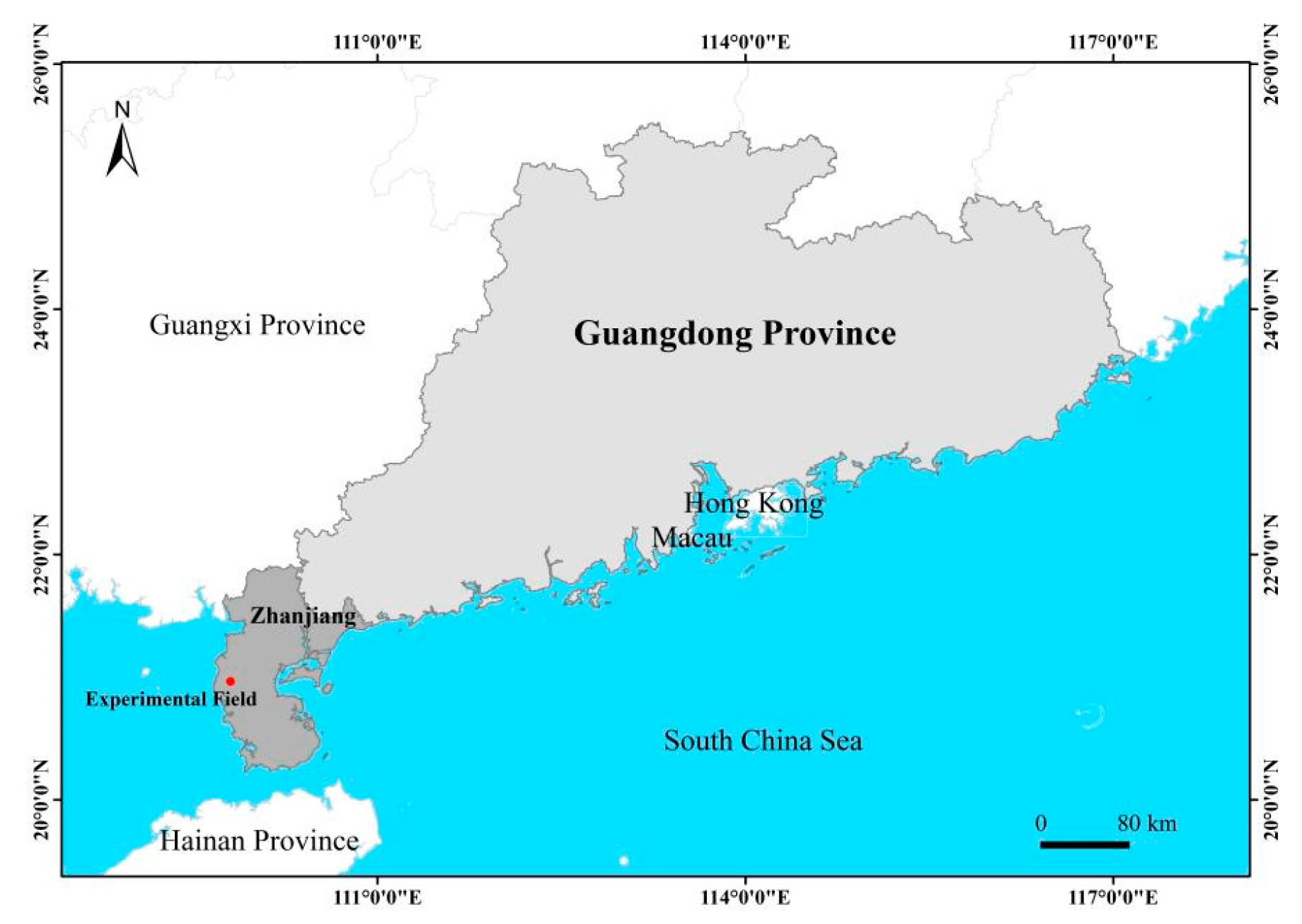


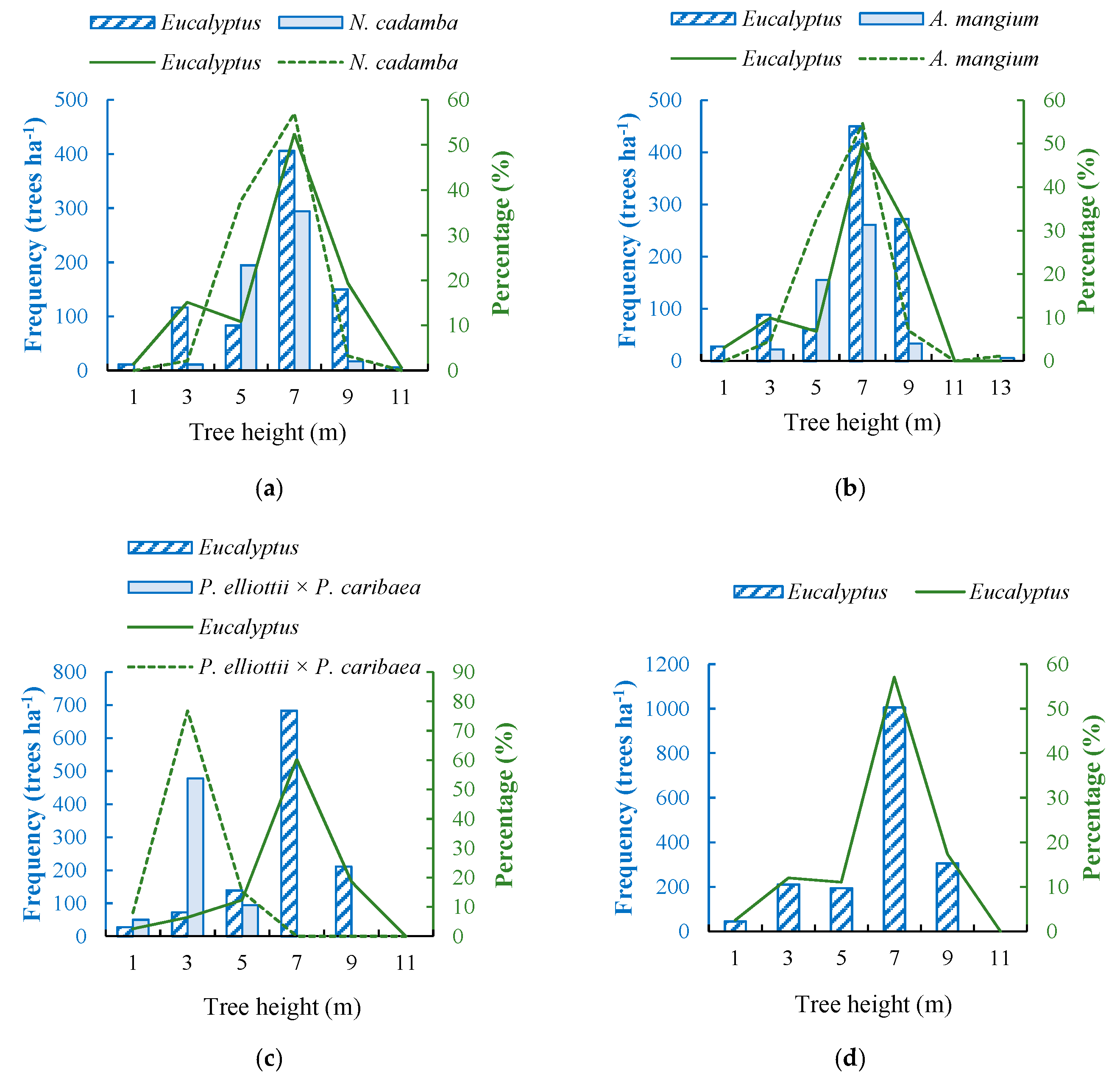
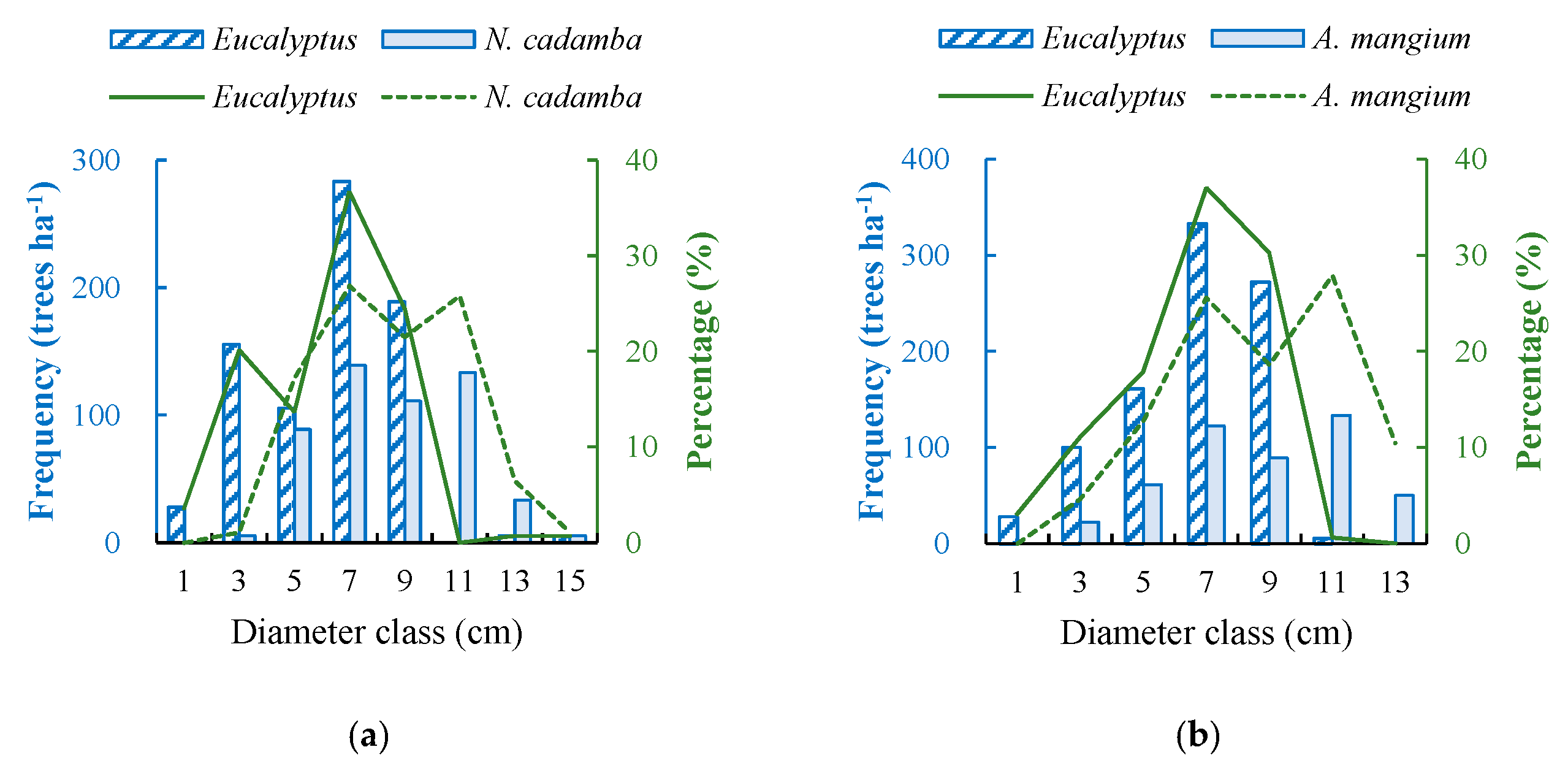
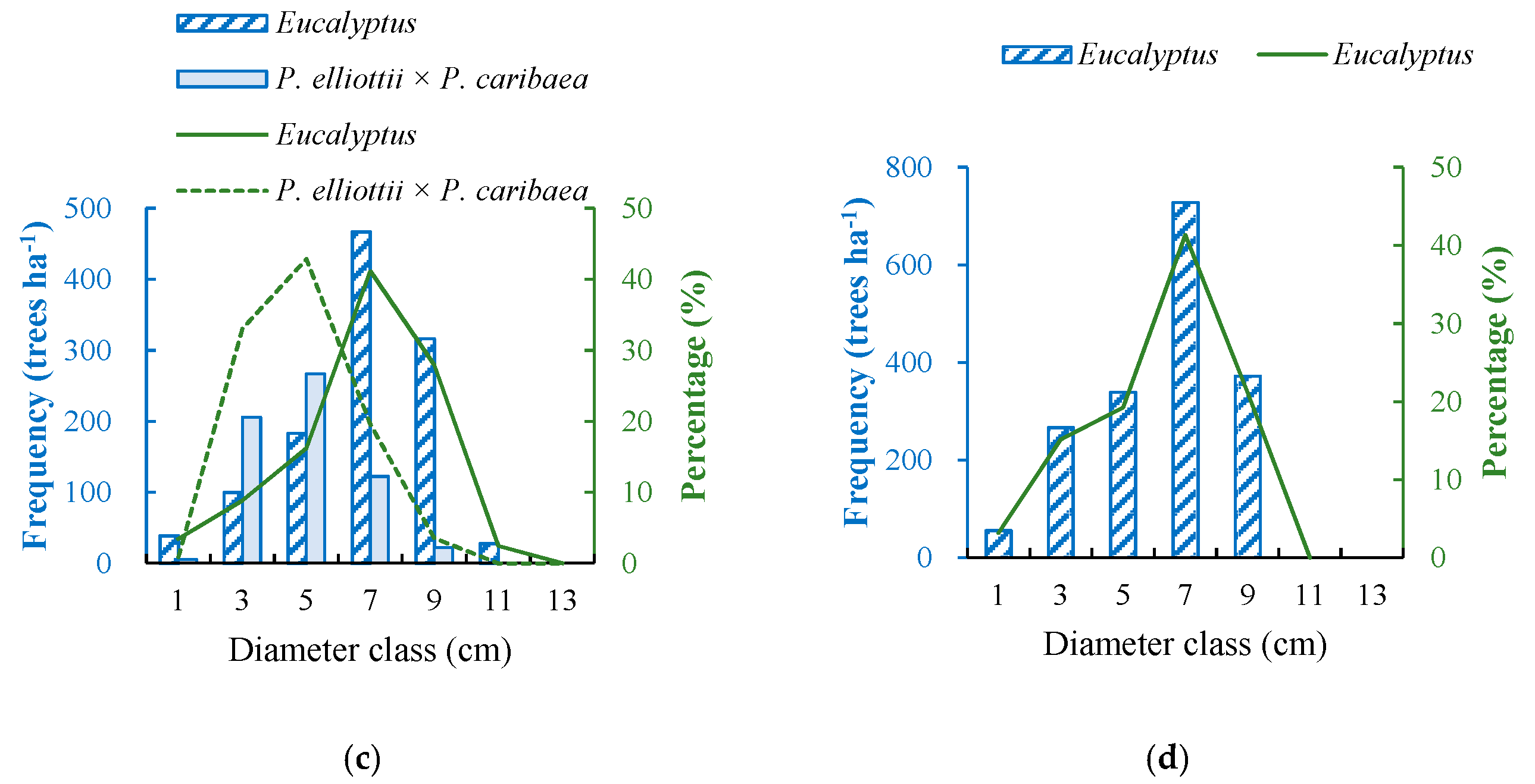
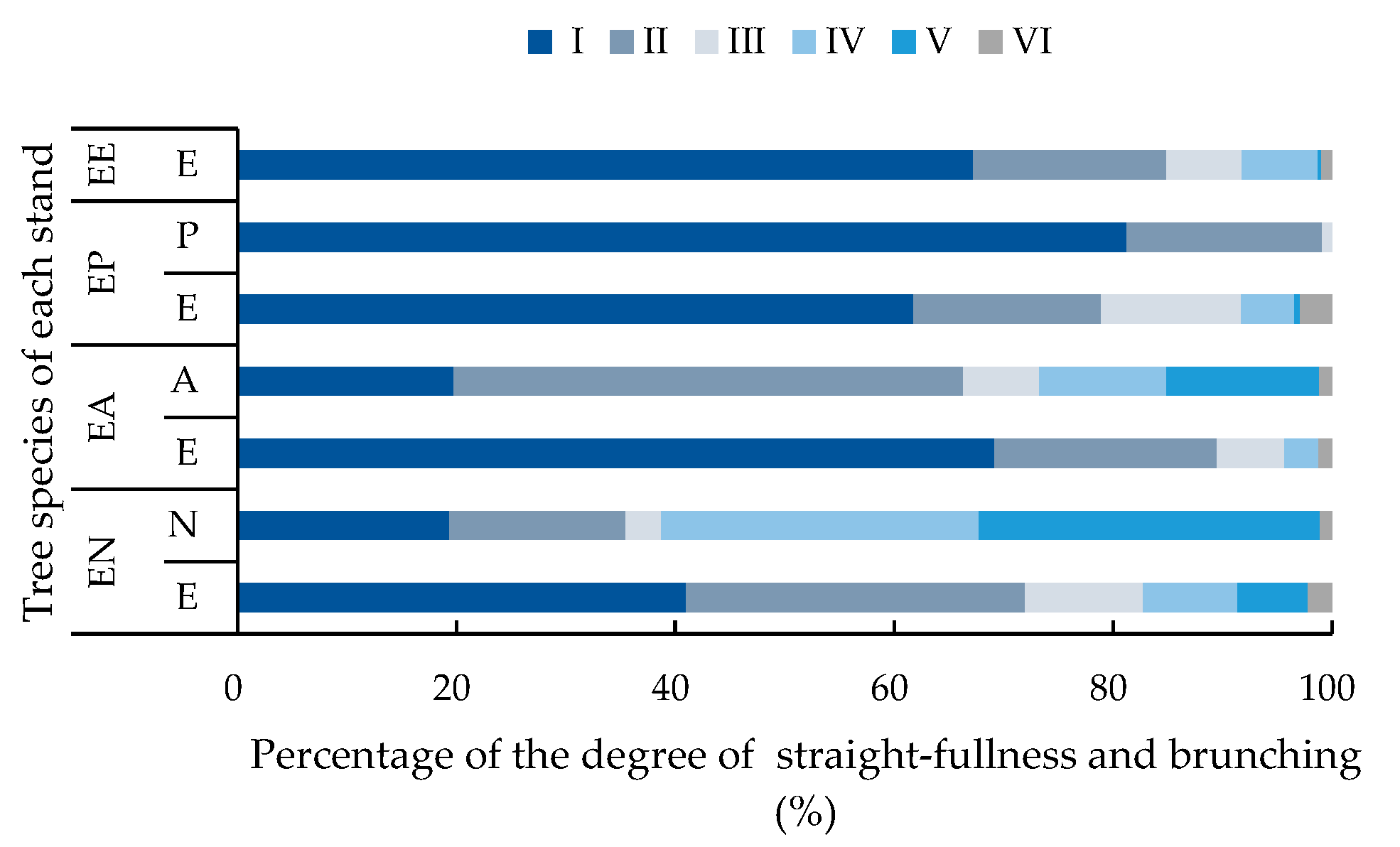
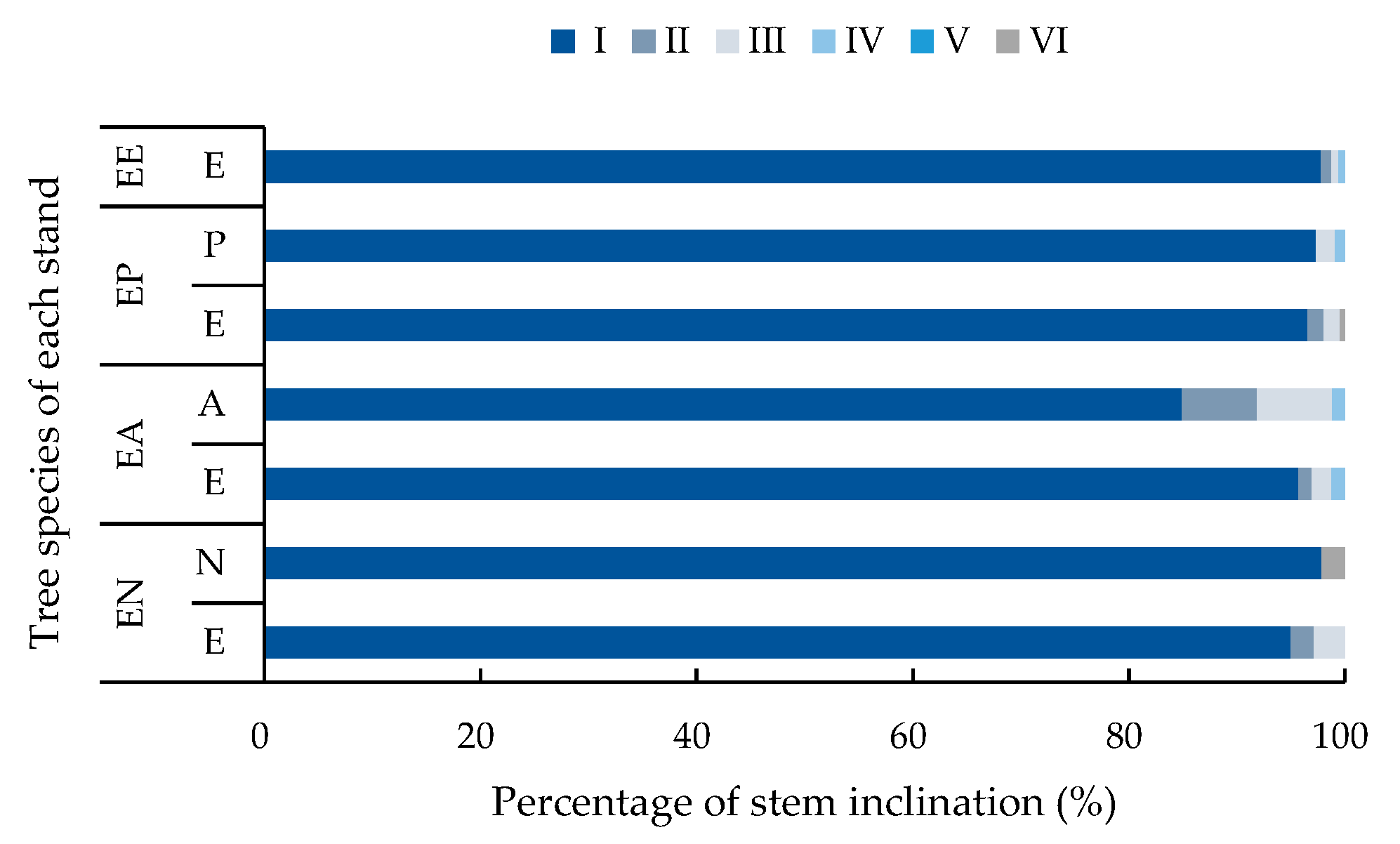
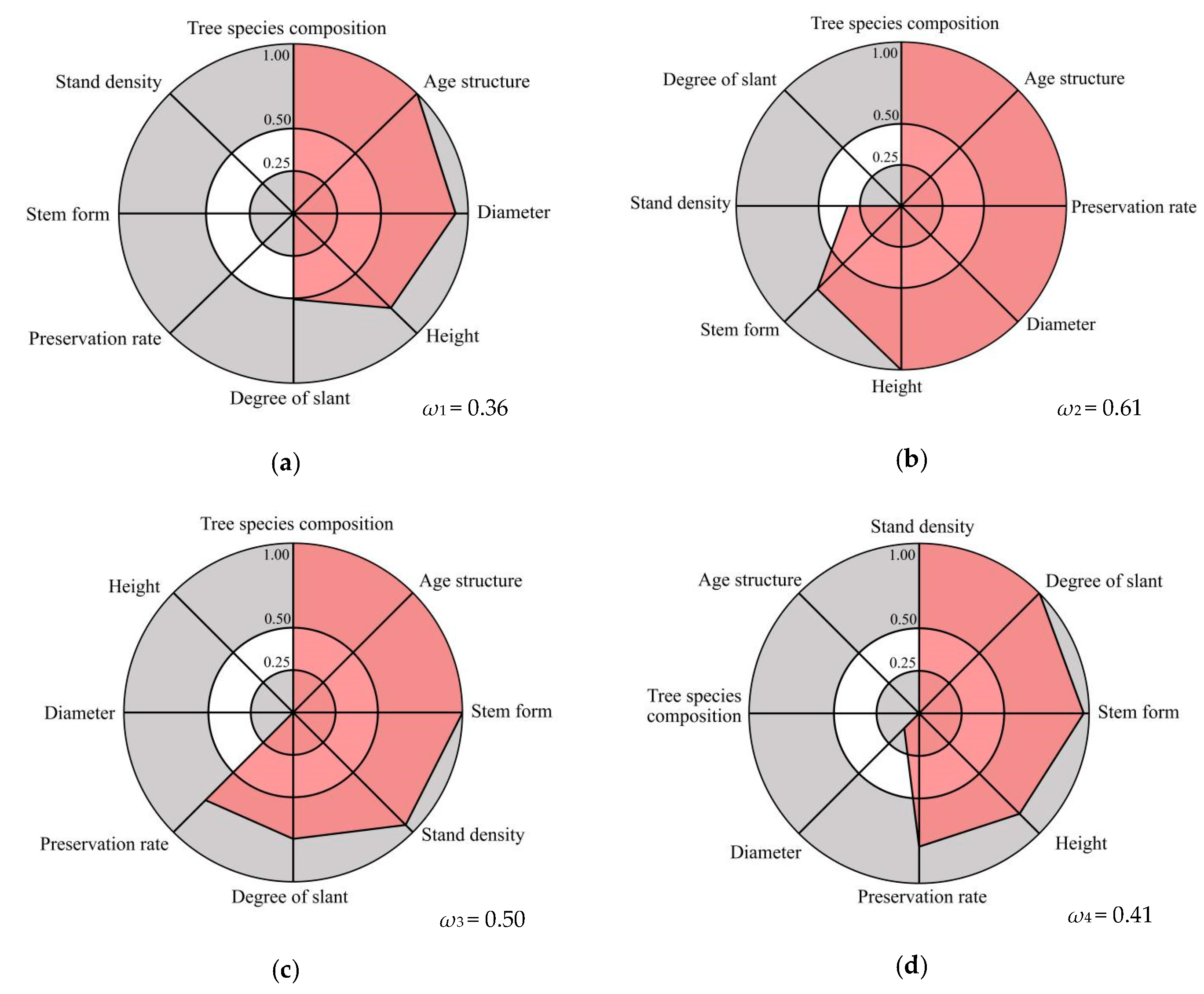
| Landing Date | Name | Number Code | Maximum Wind Speed at Landfall (m/s) | Beaufort Scale | Intensity Rank |
|---|---|---|---|---|---|
| 18 July 2014 | Rammasun | 1409 | 72 | 17 | Super Typhoon (SuperTY) |
| 16 September 2014 | Kalmaegi | 1415 | 42 | 13 | Severe Typhoon (STY) |
| 4 October 2015 | Mujigae | 1522 | 52 | 16 | Super Typhoon (SuperTY) |
| 18 August 2016 | Dianmu | 1608 | 28 | 8 | Tropical storm (TS) |
| Stem Form | Degree of Stem Inclination | ||
|---|---|---|---|
| Classification | Description | Classification | Description |
| I (Assigning a score of 6) | The tree has one single principal stem that is complete and straight (well-formed). | I (Assigning a score of 6) | The tree stem grows vertically without leaning to any side. |
| II (Assigning a score of 5) | The tree has one single principal stem that is complete and curved slightly. | II (Assigning a score of 5) | The tree stem has an inclination of 0° to 30° from the vertical axis. |
| III (Assigning a score of 4) | The tree has more than two principal stems that are branched below a third of its height. | III (Assigning a score of 4) | The tree stem has an inclination of 30° to 60° from the vertical axis. |
| IV (Assigning a score of 3) | The tree has more than two principal stems that are branched higher than one-third and lower than two-thirds of its height. | IV (Assigning a score of 3) | The tree stem has an inclination of 60° to 90° from the vertical axis. |
| V (Assigning a score of 2) | The tree has more than two principal stems that are branched higher than two-thirds of its height. | V (Assigning a score of 2) | The treetop was broken off. |
| VI (Assigning a score of 1) | The tree has one single stem that is bent badly. | VI (Assigning a score of 1) | The tree stem was broken off. |
| Stand Type | Eucalyptus | Mixed Species | Stand |
|---|---|---|---|
| EN | 41.6 | 88.9 | 49.9 |
| EA | 65.4 | 59.3 | 63.3 |
| EP | 68.0 | 50.2 | 59.7 |
| EE | 60.4 | — | 60.4 |
| Stand Type | Height Class (Unit: m) | |||||||||||||
|---|---|---|---|---|---|---|---|---|---|---|---|---|---|---|
| 1 | 3 | 5 | 7 | 9 | 11 | 13 | ||||||||
| N | % | N | % | N | % | N | % | N | % | N | % | N | % | |
| EN | 11 | 0.9 | 128 | 9.9 | 278 | 21.6 | 700 | 54.3 | 167 | 12.9 | 5 | 0.4 | 0 | 0 |
| EA | 28 | 2.0 | 111 | 8.1 | 217 | 15.7 | 711 | 51.6 | 306 | 22.2 | 0 | 0 | 5 | 0.4 |
| EP | 78 | 4.4 | 550 | 31.3 | 233 | 13.3 | 684 | 39.0 | 211 | 12.0 | 0 | 0 | 0 | 0 |
| EE | 44 | 2.5 | 211 | 12.0 | 194 | 11.0 | 1006 | 57.1 | 306 | 17.4 | 0 | 0 | 0 | 0 |
| Stand Type | Diameter Class (Unit: cm) | |||||||||||||||
|---|---|---|---|---|---|---|---|---|---|---|---|---|---|---|---|---|
| 1 | 3 | 5 | 7 | 9 | 11 | 13 | 15 | |||||||||
| N | % | N | % | N | % | N | % | N | % | N | % | N | % | N | % | |
| EN | 28 | 2.2 | 161 | 12.5 | 195 | 15.1 | 422 | 32.7 | 300 | 23.3 | 133 | 10.3 | 39 | 3.0 | 11 | 0.9 |
| EA | 28 | 2.0 | 122 | 8.9 | 222 | 16.1 | 456 | 33.1 | 361 | 26.2 | 139 | 10.1 | 50 | 3.6 | 0 | 0 |
| EP | 44 | 2.5 | 306 | 17.4 | 450 | 25.6 | 589 | 33.6 | 339 | 19.3 | 28 | 1.6 | 0 | 0 | 0 | 0 |
| EE | 55 | 3.1 | 267 | 15.2 | 339 | 19.3 | 728 | 41.3 | 372 | 21.1 | 0 | 0 | 0 | 0 | 0 | 0 |
| Stand Type | I (%) | II (%) | III (%) | IV (%) | V (%) | VI (%) |
|---|---|---|---|---|---|---|
| EN | 32.3 | 25.0 | 7.8 | 16.8 | 16.4 | 1.7 |
| EA | 52.0 | 29.4 | 6.5 | 6.1 | 4.8 | 1.2 |
| EP | 68.7 | 17.4 | 8.5 | 3.2 | 0.3 | 1.9 |
| EE | 67.2 | 17.7 | 6.9 | 6.9 | 0.3 | 1.0 |
| Stand Type | I (%) | II (%) | III (%) | IV (%) | V (%) | VI (%) |
|---|---|---|---|---|---|---|
| EN | 96.1 | 1.3 | 1.7 | 0 | 0 | 0.9 |
| EA | 91.9 | 3.2 | 3.7 | 1.2 | 0 | 0 |
| EP | 96.8 | 1.0 | 1.6 | 0.3 | 0 | 0.3 |
| EE | 97.8 | 1.0 | 0.6 | 0.6 | 0 | 0 |
| Stand Type | Stand Density (Trees/ha) | Preservation Rate (%) | Height (m) | Diameter (cm) | Stem Form | Degree of Stem Inclination | Tree-Species Composition | Age Structure |
|---|---|---|---|---|---|---|---|---|
| EN | 994 | 49.9 | 6.50 ± 0.12 | 7.29 ± 0.17 | 4.35 ± 0.10 | 5.90 ± 0.04 | 2 | 2 |
| EA | 1200 | 63.3 | 6.77 ± 0.11 | 7.38 ± 0.16 | 5.14 ± 0.08 | 5.86 ± 0.03 | 2 | 2 |
| EP | 1589 | 59.7 | 5.49 ± 0.13 | 6.12 ± 0.12 | 5.45 ± 0.06 | 5.93 ± 0.02 | 2 | 2 |
| EE | 1628 | 60.4 | 6.56 ± 0.10 | 6.28 ± 0.12 | 5.42 ± 0.06 | 5.96 ± 0.02 | 1 | 1 |
| Stand Type | Stand Density | Preservation Rate | Height | Diameter | Stem Form | Degree of Stem Inclination | Tree-Species Composition | Age Structure | Subordinate Function Values |
|---|---|---|---|---|---|---|---|---|---|
| EN | 0.00 | 0.00 | 0.79 | 0.93 | 0.00 | 0.51 | 1.00 | 1.00 | 0.53 |
| EA | 0.32 | 1.00 | 1.00 | 1.00 | 0.72 | 0.00 | 1.00 | 1.00 | 0.76 |
| EP | 0.94 | 0.73 | 0.00 | 0.00 | 1.00 | 0.75 | 1.00 | 1.00 | 0.68 |
| EE | 1.00 | 0.78 | 0.83 | 0.12 | 0.97 | 1.00 | 0.00 | 0.00 | 0.59 |
Publisher’s Note: MDPI stays neutral with regard to jurisdictional claims in published maps and institutional affiliations. |
© 2021 by the authors. Licensee MDPI, Basel, Switzerland. This article is an open access article distributed under the terms and conditions of the Creative Commons Attribution (CC BY) license (https://creativecommons.org/licenses/by/4.0/).
Share and Cite
Deng, H.; Shen, L.; Yang, J.; Mo, X. Stand Stability of Pure and Mixed-Eucalyptus Forests of Different Tree Species in a Typhoon-Prone Area. Forests 2021, 12, 458. https://doi.org/10.3390/f12040458
Deng H, Shen L, Yang J, Mo X. Stand Stability of Pure and Mixed-Eucalyptus Forests of Different Tree Species in a Typhoon-Prone Area. Forests. 2021; 12(4):458. https://doi.org/10.3390/f12040458
Chicago/Turabian StyleDeng, Haiyan, Linlin Shen, Jiaqi Yang, and Xiaoyong Mo. 2021. "Stand Stability of Pure and Mixed-Eucalyptus Forests of Different Tree Species in a Typhoon-Prone Area" Forests 12, no. 4: 458. https://doi.org/10.3390/f12040458
APA StyleDeng, H., Shen, L., Yang, J., & Mo, X. (2021). Stand Stability of Pure and Mixed-Eucalyptus Forests of Different Tree Species in a Typhoon-Prone Area. Forests, 12(4), 458. https://doi.org/10.3390/f12040458




